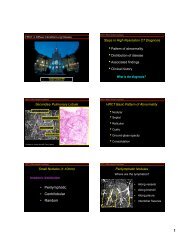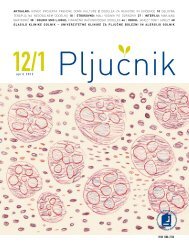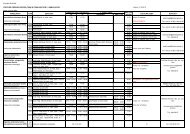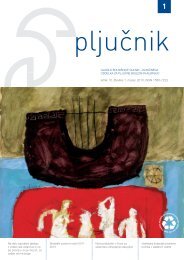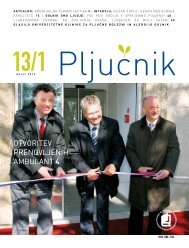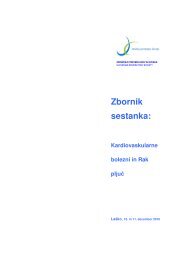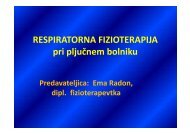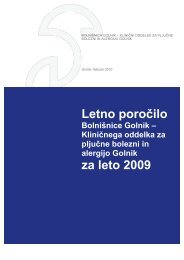Golniški simpozij 2011 Zbornik povzetkov
Golniški simpozij 2011 Zbornik povzetkov
Golniški simpozij 2011 Zbornik povzetkov
Create successful ePaper yourself
Turn your PDF publications into a flip-book with our unique Google optimized e-Paper software.
Patient safety – the preanalytical<br />
impact on quality of laboratory reports<br />
Pika Meøko Brguljan<br />
University Clinic for Respiratory Diseases and Allergy Golnik, Clinical Chemistry Department, Golnik,<br />
Slovenia<br />
Patient safety, the freedom from accidental or unnecessary harm due to adverse events occurring in<br />
any healthcare setting, directly affects the quality of care. The Institute of Medicine (IOM) report, To err<br />
is human, dramatically increased level of concern about adverse events and patient safety in healthcare,<br />
including errors in laboratory medicine (1). Even a low incidence of laboratory mistakes among<br />
the billions of tests performed every day worldwide could have important public health and patient<br />
safety implications. While the IOM report presented few data on errors in laboratory medicine, it has<br />
wide-reaching implications for all disciplines. The IOM report, Crossing the quality chasm (2), stressed<br />
the concept of patient-centered care and the fact that complex systems are characterized by specialization<br />
and interdependency. The evidence reported can be translated into a better understanding of<br />
the importance of the total testing process (TTP) – preanalytical, analytical and postanalytical, as the<br />
right framework for patient safety in laboratory medicine. The TTP consists of a series on interrelated<br />
processes, each involving a series of a process step, every one of which can result in an error (3).<br />
In the last years, in our laboratory many strategies are used to reduce errors, such as improved laboratory<br />
technology, internal quality control procedures, external quality assurance programs, educational<br />
programs, licensing of laboratory professionals, certification of laboratory (as the part of our<br />
clinic’s ISO 9001:2000 and DNV accreditation certificates). Laboratory also fulfil the Slovenian regulatory<br />
requirements in laboratory medicine and gain the working license in the year 2009. In the<br />
past, the preanalytical phase has been often overlooked as a source of errors, evidence from recent<br />
studies shows that a large percentage of laboratory errors occur in the preanalytical steps (4). In the<br />
laboratory several steps have already been taken to increase awareness and establish a governance<br />
of the preanalytical aspect of laboratory processes. Standardization and monitoring of the most common<br />
preanalytical errors have been implemented in the every-day work in the laboratory. Quality indicators<br />
and the error monitoring system of the preanalytical phase are tools that can be used to<br />
supervise the activity carried out in the laboratory and activities in relation to the clinical laboratory.<br />
Till the data are collected and corrective actions, such as education of staff on preanalytical issues,<br />
have been taken, a big improvement in fulfilment of the quality specifications have been detected.<br />
The interdisciplinary approach to manage the quality of the preanalytical phase is a good approach<br />
to avoid and reduce laboratory errors in TTP. In the future our aim is to integrate more effective error<br />
tracking and quality indicator reporting system to our laboratory informaton system (LIS). Continuous<br />
actions for all involved in the processes and move from error reporting to risk managament is of extreme<br />
importance for patient safety.<br />
12



